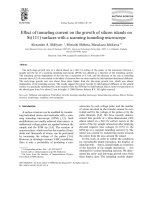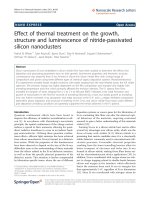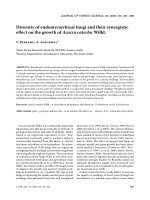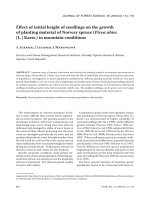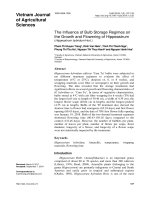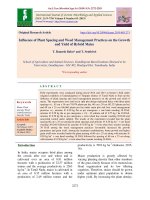Effect of vermicompost with microbial bio inoculums on the growth parameter of coriander (Coriandrum sativum L.)Effect of vermicompost with microbial bio inoculums on the growth parameter
Bạn đang xem bản rút gọn của tài liệu. Xem và tải ngay bản đầy đủ của tài liệu tại đây (430.1 KB, 10 trang )
Int.J.Curr.Microbiol.App.Sci (2020) 9(8): 613-622
International Journal of Current Microbiology and Applied Sciences
ISSN: 2319-7706 Volume 9 Number 8 (2020)
Journal homepage:
Original Research Article
/>
Effect of Vermicompost with Microbial Bio Inoculums on the Growth
Parameter of Coriander (Coriandrum sativum L.)
P. Sakthivel*, Alice R. P. Sujeetha, G. Ravi, A. G. Girish and P. Punnam Chander
National Institute of Plant Health Management, Ministry of Agriculture and Farmers Welfare,
Govt. of India, Rajendranagar, Hyderabad – 500030, India
*Corresponding author
ABSTRACT
Keywords
Bio inoculant,
Coriander, FYM,
Organicmanure,
Vermicompost,
Article Info
Accepted:
10 July 2020
Available Online:
10 August 2020
Vermicompost is an organic fertilizer which converts waste to wealth in a safe and healthy
way as it is produced by biopotential of earthworm. It contains plant growth hormones,
enzymes, microbial population, and free of harmful pathogens. Application of such a
microbiologically active organic substrate may have important effects on the microbial
properties of the media. A study was conducted to find out the effect of organic manures in
combination with microbial bio inoculants on the growth, plant height, wet weight, dry
weight, and yield of coriander. The experiment was carried out as in open field with seven
treatments at National Institute of Plant Health Management, Rajendranagar, Hyderabad in
December, 2019. The analysis of the variance results revealed that the effect of the type of
treatments on fresh weight, number of leaves, root length, fresh weight, dry weight,
chlorophyll content and biomass yield showed significant effect when compared to
control. The results also showed that the interaction of vermicompost and bio inoculants
were significantly enhanced the morphological character of the coriander crop. Therefore,
the application of bio inoculants with any of the organic manure to be a potential source of
plant nutrients which contributes the growth of coriander.
Vermicompost is an organic manure produced
as the vermicast by earthworm feeding on
biological waste material; plant residues
(Rathore et al., 2007) and it is one of the best
source of nutrients improves the physical and
chemical properties of crops (Sinha et al.,
2010). The vermicompost is rich in NPK and
micronutrients (Palanichamy et al., 2011).
Vermicompost and Biofertilizer are also
useful substitutes to inorganic fertilizers
which improves the soil quality. Biofertilizers
are living organisms that have an ability to
mobilize nutrients from unusable form
Introduction
“Sustainable agriculture” can be ensured in
future with the help of organic farming
systems which includes various processes of
biological origin such as compost and vermin
compost. Compost and vermicompost are
appropriate technologies which convert waste
to wealth. Vermicomposting is increasingly
becoming popular as an organic farming and
solid waste management technique and it
produces two vital bio fertilizers, vermin
compost and vermin wash (Kaur et al., 2015).
613
Int.J.Curr.Microbiol.App.Sci (2020) 9(8): 613-622
through biological process and these groups
of microorganisms may either fix atmospheric
nitrogen or solubilise insoluble phosphorus
and make them available for crops.
Azospirillum,
Phosphobacteria,
VAM,
Azotobacter, Rhizobium etc., are the main
types of organisms widely recommended for
many field crops. Biofertilizers were found to
have positive impact to soil fertility resulting
in an increase in crop yield without causing
any type of environmental wastes or soil
hazards. Various studies proved that
significant improvement in growth and yield
and quality of vegetables with different
biofertilizer applications on various crop
(Yadav et al., 2001 & Sanjukta Biswas,
2014). Similarly, application of organic
manure, vermicompost and biofertilizer
combinations has led to quality agricultural
products (Sanchez et al., 2008 and
Velmurugan et al., 2008).
Fresh leaves are being used in cooking,
flavouring, beverages etc and seeds are used
in preparation of value added products (Bhat
et al., 2014). It is sometimes used to mask
odd flavors (Parthasarathy et al., 2008).
Several
studies
have
reported
that
vermicompost can increase the growth and
biomass of some medicinal plants such as
chamomile (Fallahi et al., 2008), plantain
(Sanchez et al., 2008), coriander (Singh et al.,
2009 & Darzi et al., 2012), fennel (Darzi et
al., 2007), cumin (SaeidNejad and Rezvani
Moghaddam, 2011), etc. Some other studies
have reported that biostimulants such as
Azotobacter chroococcum and Azospirillum
lipoferum could cause increased growth and
biomass in a few medicinal plants such as
coriander (Darzi et al., 2012), fennel
(Mahfouz and Sharaf Eldin, 2007), turmeric
(Velmurugan et al., 2008) etc,.The present
study was carried out with a aim to evaluate
the effect of vermicompost along with
bioinoculants with due regards to growth, and
biomass for coriander. The growth parameters
were expressed as number of leaves, fresh
weight and dry weight.
Coriander (Coriandrum sativum L.) is one of
the most important of vegetable, spice and
medicinal plant which belongs to the family
Apiaceae (Umbelliferae) is mostly cultivated
from its seeds throughout the year. India is the
major producer, consumer and exporter of
coriander in the world with an annual
production of approximately (1000 metric
tonnes in 2019).This plant is very much
aromatic and has several uses in food and in
other industries. Plants have played a major
role in maintaining human health and
civilizing the value of human life for
thousands of years (Dhankar et al., 2011). It is
also used to perfumes a usages. All parts of
plant are edible, fresh leaves can be used for
garnishing and are common ingredient in
many foods like chutneys and salads. The
green herb is also engaged for the preparation
of either steam distilled essential oil or the
solvent extracted oleoresin (Mhemdi et al.,
2011). Fresh juice of coriander is
tremendously beneficial in therapeutic many
deficiencies correlated to vitamins and iron.
Materials and Methods
The experiment was carried out at National
Institute of Plant Health Management,
Rajendranagar during the period of December
2019 to January 2020. The experimental field
were ploughed two times and divided into 7
plots. Each plots were 3 m long and 2 m wide
in which the coriander seeds (local hybrid
variety) were transplanted in seven rows. The
experiment was conducted in an irrigated
plots. One week old vermicompost (VC), Dry
compost from kitchen wastes and composted
Farm Yard Manure (FYM) was used as
organic manure for the experiment. Further,
mixture of bioinoculants (Biofertilizer (BF)Azotobacter,
Phosphorus
Solubilising
Bacteria
and
Biopesticides
(BP)
–
(Trichoderma and Pseudomonas) were
614
Int.J.Curr.Microbiol.App.Sci (2020) 9(8): 613-622
admixed with the organic manures. All of
these manures and bio fertilizers were
produced at NIPHM. The experiment consists
of seven treatments as follows:
followed by Duncun test revealed that
significant difference in plant growth
parameters such as plant height (F=113.73,
P<0.001 at 15 DAS &F=112.09, P<0.001 at
30 DAS), no of leaves/plant (F=55.54,
P<0.001 at 15 DAS &F=45.56, P<0.001 at 30
DAS), root length (F=55.12, P<0.001 at 15
DAS &F=58.79, P<0.001 at 30 DAS), fresh
weight (F=4.58, P<0.001 at 30 DAS) and dry
weight (F=24.43, P<0.001 at 30 DAS) was
among the treatments. Photo.1 showed the
growth parameters of different treatments.
All organic manures VC, FYM, dry compost
were added @ 5kg per experimental plot at
two times (one at the time of land preparation
and another at on 5 DAS). The bio inoculants
were applied along with vermicompost and
FYM (@2g /kg) during transplanting of
seedlings and 5 DAS in the experimental
fields. Out of 7 rows, the middle 4 rows were
selected for the collection of data to avoid the
effect of other environmental factors. In each
row 10 plants from each row was selected
randomly (10 x 4 rows =40 plants)and
uprooted to determine the following
characters from each experimental plot - plant
height, root length, number of leaves/plant,
fresh weight and dry weight of the plants on
15th and 30th day of planting. The chlorophyll
content in the leaves was measured by
chlorophyll meter after the harvest of the
plant (30th day).
Plant Height (cm)
Among the different treatment, the highest
mean plant height (cm) was recorded in T1
(12.87 ± 2.14), and T4 (11.28 ± 1.22) and
lowest plant height (4.68 ± 0.94cm) was
observed in T7 (control) at 15 DAS of
coriander plant. While at 30 DAS the highest
mean plant height was recorded in three
treatments T1 (20.25 ± 1.89) followed by T4
(20.15 ± 2.46) ≈ T5 (20.00 ±2.39) and lower
plant height exhibited in control plot T7
(11.27 ± 1.13) (Table 2).
The roots were cleaned carefully to remove
adhering soil particles. After the harvest the
plants were dried in oven at 65˚C for 72 hours
and dry weights were recorded in all the
treatments. Total yield was measured based
the total fresh weight of plant after the harvest
(30th day).One-way analysis of variance
(ANOVA) and Duncan’s t multiple ranged
test were used to identify the homogenous
type of the data sets among different
treatments for different plant parameters in
different treatments.
Root Length (cm)
The mean length of root length (cm) varied
significantly among the different treatments
when compared to control plot both at 15 &
30 DAS. The maximum root length (5.05
±1.23) was achieved in T1 followed by T4
(4.23 ± 0.88) ≈T5 (4.12 ± 1.32) and minimum
root length observed in control (1.75 ±0.56) at
15 DAS. Similarly, the maximum root length
was found from T1 (6.69 ±1.09) which was
statistically identical with T3 (5.93 ±1.04) ≈
T5 (5.73 ±0.95) while minimum from T7
(3.16 ±0.54) at 30 DAS (Table 2).
Results and Discussion
Effect of different organic composts are
admixed
with
bio
inoculants
on
morphological characters such as plant height,
number of leaves, root length, fresh weight
and dry weight of the coriander crop is given
in Table 2.The data tested by ANOVA
Leaves Number (nos.)
Statistically significant variation was found
among the treatments for number of leaves.
Duncan’s multiple range tests on mean
615
Int.J.Curr.Microbiol.App.Sci (2020) 9(8): 613-622
maximum number of leaves was found from
T1 (6.02 ± 0.94), T4 (5.92 ±1.24), T3 (5.75 ±
1.33), T5 (5.62 ± 1.12) and T6 (5.60 ±0.95)
followed by T2 (4.82 ± 0.71) whereas
minimum from T7 (2.62 ± 0.58) at 15 DAS.
However, the performance order of effect of
different treatment on mean number of leaves
per plant were T1 (10.05 ± 2.48) ≈T4 (10.05 ±
2.48) ≈ T3 (10.02 ± 2.33) > T5 (9.42 ± 1.83)
> T6 (8.42 ±1.64) > T2 (7.40 ± 0.9) > T7
(5.72 ± 0.75) at 30 DAS (Table 2).
present results show that the interaction of
vermicompost and bio inoculant was
significant.
Chlorophyll Content
One way analysis of variance test on
chlorophyll
content
(g/kg)
revealed
significant differences among different types
of treatment (F=60.98, P <0.001 at 30 DAS).
The maximum and minimum average
chlorophyll Content (g/kg) was in T1 (21.50)
and T7 (14.13), respectively. The Chlorophyll
Content in coriander plant was in the order:
T1 (21.50) > T5 (19.24) > T6 (18.72) > T2
(17.92) = T3 (17.62) > T4 (16.98) > T7
(13.38)(Figure 1).
Fresh weight of Plant (g)
The ANOVA based Duncun test showed the
highest fresh weight (g) of plant were
obtained in 5 treatments (T1= 0.80 ± 0.07;
T4= 0.79 ±0.04; T5 =0.78 ±0.18; T3=0.78 ±
0.05 and T6=0.71 ± 0.18) followed by T2
(0.70 ± 0.15). The lowest fresh weight of
plant (0.60 ± 0.25) was obtained in T7
(Control).
Total Yield
Effect of different treatment on coriander
yield based on the total weight (kg) measured
after the harvest was presented in Figure 2.
Significant increase in the yield of 1.66 kg
was the recorded from plot treated with
vermicompost + biofertilizers + biopesticides
(T1). Followed by T4 (1.56 kg) > T5 (1.45
kg) > T3 (1.40 kg) yield better results. The
poorest yield was received from the control
plot (0.825 kg).
Dry weight of Plant (g)
Significant increase in dry weight of plant
was observed among the different treatments.
The highest dry weight of plant (g) were
obtained in T1with a mean value of 0.30 ±
0.12 g and less in the control treatment (T7)
with value of 0.09 ± 0.00 (Table 2).The
Table.1 Treatment design with bioinoculants
Treatments
T1 - VC+BF+ BP
T2 - FYM+BF+BP
T3 - VC+FYM+BF+BP
T4 - VC+FYM+VW
T5 - Dry compost
T6 –Vermicompost
T7 – Control
Combination
Vermicompost + Biofertilizers + Biopesticides
Farm Yard Manure + Biofertilizers + Biopesticides
Vermicompost + Farm Yard Manure + Biofertilizers +
Biopesticides
Vermicompost + Farm Yard Manure + Vermiwash
Dry compost from vegetable waste
Vermicompost
No treatment
616
Int.J.Curr.Microbiol.App.Sci (2020) 9(8): 613-622
Table.2 Effect of vermicompost and other organic manures on morphological parameter of coriander
Treatments
T1-VC+BF+ BP
T2-FYM+BF+BP
T3 VC+FYM+BF+BP
T4-VC+FYM+VW
T5-Dry compost
T6-Vermicompost
T7- Control
Height of plant (cm)
(mean ± SD)
15 days
12.87 ± 2.14a
10.95 ± 1.13b
11.28 ± 1.22a
10.32 ± 1.73b
10.17 ± 1.23b
9.75 ± 1.54b
4.68 ± 0.94c
Root length(cm)
(mean ± SD)
30 days
15 days
a
20.25 ± 1.89 5.05 ±1.23a
17.20 ± 2.05b 2.53 ± 0.86d
19.80 ± 2.25a 3.06 ± 0.89c
20.15 ± 2.46a 4.23 ± 0.88b
20.00 ±2.39a 4.12 ± 1.32b
15.19 ±1.88c 2.76 ±0.93d
11.27 ± 1.13d 1.75 ±0.56e
30 days
6.69 ±1.09a
4.12 ±1.09c
5.93 ±1.04a
5.34 ±1.19b
5.73 ±0.95a
4.74 ±0.64c
3.16 ±0.54d
Significant differences(P<0.05) are indicated by different letters
The values are represented a mean +Standard deviation of 20 samples
617
No.of leaves /plant
(mean ± SD)
15 days
6.02 ±0.94a
4.82 ±0.71b
5.75 ±1.33a
5.92 ±1.24a
5.62 ±1.12a
5.60 ±0.95a
2.62 ±0.58c
30 days
10.57±2.21a
8.42 ±1.64c
10.02 ±2.33ab
10.05±2.48ab
9.42±1.83b
6.40±0.90d
5.72±0.75d
Fresh weight
Dry weight
(gm)
(gm)
(mean ± SD) (mean ± SD)
30 days
30 days
a
0.80 ±0.07
0.30±0.12a
0.70 ±0.15c
0.11±0.02c
0.78 ±0.05ab
0.12±0.02c
a
0.79 ±0.04
0.25±0.12b
0.78 ±0.18a
0.16±0.06b
0.71±0.18b
0.14±0.07b
c
0.60±0.25
0.09±0.00d
Int.J.Curr.Microbiol.App.Sci (2020) 9(8): 613-622
Photo.1 Effect of different treatments on plant growth parameters
618
Int.J.Curr.Microbiol.App.Sci (2020) 9(8): 613-622
Coleus, especially a stimulation of rooting,
time of flowering, lengthening of internode.
Weed intensity
The weed intensity was measured after
harvesting of the plants based on presence of
total count in the experimental plots are 127,
210, 186, 135, 35,85, 28 in T1, T2, T3, T4,
T5, T6, T7 respectively (Figure 3).
The chlorophyll is an integral component of
plant pigments and plays a main role in the
process of photosynthesis. It is the molecule
that absorbs sunlight and uses its energy to
synthesis carbohydrates from CO2 and water.
It also plays an important role in ATP
synthesis (Kochot et al., 1998 and Ravimycin,
2016). The increased chlorophyll content to
the vermicompost application was recorded in
the present study. Further, a study by Maya
and Satish (2015) showed that the significant
increase was observed in the brinjal plants
which were sprayed with vermiwash and also
added in the soil treatment. Study conducted
by Thenmozhi, et al., (2010), shows that
bioinoculants
viz.,
Azospirillum
and
Pseudomonas, and organic manure as
vermicompost had influenced the shoot and
root length, plant biomass and number of
leaves in Amaranthus retroflexus. A study by
Ravimycin (2016) reported that application of
vermicompost
increased
all
the
morphological, pigment, protein and nutrient
content in coriander plants when compared to
FYM and control treatment. Gandhi and
Sivakumar (2010) reported that the combined
form of inoculation of vermicompost
increased the in rice grain quality like hulling
percentage, milling percentage of grain and
water uptake, volume expansion, elongation
ratio, protein and amylose of rice kernel. It
was reported that the combined inoculation of
bioinoculants increased the number of panicle
per plant (Yanni and El-Fattah, 1999 &
Shanmugam and Veeraputhran, 2000). In the
present work also similar trend was observed
in T1 and T4.Hence, vermicompost with
bioinoculants combination or vermicompost +
FYM + vermiwash combination to be an
effective organic fertilizer which contributes
the growth of plants and helps in production
of coriander crop.
.
Among the various treatment used in the
study, the significant effect on the growth
parameter of coriander crop i.e plant height,
no. of leaves, root length, fresh weight and
dry weight as well as chlorophyll content
were enhanced by the organic manures
especially with vermicompost admixed with
bio inoculant than the untreated plots
(control). This might be due to excellent
supply of better nutrients and plant growth
promoters to the plants which is present in the
worm casts. The vermicompost with a
relatively high content of humus-like
compounds, active microorganisms and
enzymes,
greatly contribute
to
the
enhancement of the biochemical fertility of
soils degraded by intensive – cultivation,
pollution or natural causes (Perucci, 1992).
The casts of earthworm is one of the most
useful and active agent in introducing suitable
chemical, physical and microbiological
changes in the soil and, thereby, directly
increasing the fertility and crop producing
power in the soil (Joshi and Kelkar, 1951).
There are many reports that vermicompost
increased the growth and yield of different
plants viz., rice (Gandhi and Sivakumar,
2010), garden pea (Meena et al., 2007),
cabbage (Mulusew Getnet and Nagappan
Raja, 2013), wheat (Nijhawan and Kanwar,
1951), tomato (Hossein Alidadi, et al., 2014),
coconut (Thomas et al., 2012).Green gram
(Manoharan and Ganesamoorthi, 2015),
Brinjal (Maya and Satish, 2015), Garllic
(Surindra Suthar, 2009). A study by Tomati et
al., (1983) revealed that positive effect of
vermicompost on the growth of Begonias and
619
Int.J.Curr.Microbiol.App.Sci (2020) 9(8): 613-622
In conclusion the results revealed that
application of vermicompost in combination
with microbial inoculums gave excellent
results on the plant growth and yield
parameter when compared with other
treatments followed by T4, T3 and T5 also
yielded better results over the control plot.
Therefore, the vermicompost and enriched
with bio inoculants or Vermicompost (50%) +
FYM (50%) + Vermiwash may be used as
plant growth media for sustainable coriander
crop production.
review on Justicia adhatoda - A
potential source of natural medicine.
African Journal of Plant Science,
5(11):620-627.
Fallahi, J., Koocheki, A.and Rezvani
Moghaddam P.2008. Investigating the
effects of organic fertilizer on quantity
index and the amount essential oil and
chamazulene in chamomile (Matricaria
recutita).Agricultural Research: Water,
Soil and Plant in Agriculture, 1(8): 157168.
Gandhi, A. and Sivakumar, K. 2010. Impact
of
vermicompost
carrier
based
bioinoculants on the growth, yield and
quality of rice (Oryza sativa L.) C. V.
NLR 145. The Ecoscan, 4(1):83-88.
HosseinAlidadi, Ali Reza Saffari, Damon
Ketabi, RoyaPeiravi and Ahmad
Hosseinzadeh.2014. Comparison of
Vermicompost and Cow Manure
Efficiency on the Growth and Yield of
Tomato Plant. Health Scope, 3(4):
e14661.
Joshi, N.V. and Kelkar, B.V. 1951. The role
of earthworms in soil fertility. Indian
Journal ofAgriculture Sciences, 21
(4):189-196.
Kaur, P., Bhardwaj, M. and Babbar, I.
2015.Effect of Vermicompost and
Vermiwash on Growth of Vegetables.
Research Journal of Animal,Veterinary
and Fishery Sciences, 3(4): 9-12.
Kochot, C.K., Golbale, S.B. and A. Purohit,
1998.In: Textbook of pharmacognosy,
NiraliPrakashan, Pune, pp. 17-18.
Mahfouz,
S.A.
and
SharafEldin,
M.A.2007.Effect of mineral vs.
biofertilizer on growth, yield, and
essential oil content of fennel
(Foeniculum
vulgare
Mill).
International agrophysics, 21(4): 361366.
Manoharan, K. and Ganesamoorthi, R.
2015.Nutrient status and plant growth
promoting potentiality of vermicompost
Acknowledgements
Authors are highly thankful to Smt. G.
Jayalakshmi, IAS, Director General, National
Institute of Plant Health Management for the
encouragement and funding to conduct the
experiments. The kind cooperation of Mr.
Pawar JRF (PHM) during whole research
period is highly acknowledged.
References
Bhat, S., Kaushal, P.,Kaur, M. and Sharma,
H. K. 2014. Coriander (Coriandrum
sativum L.): Processing, nutritional and
functional aspects. African Journal of
Plant Science, 8(1): 25-33.
Darzi, M.T., Ghalavand, A., Rejali, F. and
Sephidkon,
F.2007.Effects
of
Biofertilizers Application on yield and
yield
components
in
fennel
(Foeniculum vulgare Mill.). Iranian
Journal of Medicinal and Aromatic
Plants, 22(4): 276-292.
Darzi, M.T., Haj Seyed Hadi, MR. and Rejali,
F.2012. Effects of Cattle Manure and
Biofertilizer Application on Biological
Yield, Seed Yield and Essential oil in
Coriander
(Coriandrum
sativum).
Journal of Medicinal Plants, 9(11): 7790.
Dhankar, S., Kaur, R., Ruhil, S., Balhara, M.,
Dhankhar, S. andChhillar, A.K.2011.A
620
Int.J.Curr.Microbiol.App.Sci (2020) 9(8): 613-622
and biocompost on Vigna radiata.
World Journal of Pharmacy and
Pharmaceutical Sciences, 4(8):830-838.
Maya, M.J. and Satish, A.B. 2015. Effect of
Vermiwash on the Growth Parameters
of Solanum melongena L. (Brinjal
Plant). International Journal of Current
Research in Biosciences and Plant
Biology, 2(9): 24-29.
Meena, R.N., Singh, Y., Singh, S.P., Singh,
J.P. and Singh, K. 2007. Effect of
sources and level of organic manure on
yield: Quality and economics of garden
pea (PisumsativumL.) in Eastern Uttar
Pradesh. Vegetation Science, 34(1): 6063.
Mhemdi, H., Rodier, E., Kechaou, N. and
Fages, J. 2011.A supercritical tuneable
process for the selective extraction of
fats and essential oil from coriander
seeds. Journal of Food Engineering,
105(4):609-616.
MulusewGetnet and Nagappan Raja. 2013.
Impact of Vermicompost on Growth
and Development of Cabbage, Brassica
oleracea Linn. and their Sucking Pest,
Brevicoryne
brassicae
Linn.
(Homoptera: Aphididae). Research
Journal of Environmental and Earth
Sciences, 5(3): 104-112.
Nijhawan,
S.D.
and
Kanwar,
J.S.,
1951.Physio-chemical properties of
earthworm casting and their effect on
the productivity of soil.India Journal of
Agriculture Sciences, 22 (4), 357-373.
Palanichamy, V., Mitra, B., Reddy, N.,
Katiyar,
M.,
Rajkumari,
R.B.,
Ramalingam, C. and Aranganthan, C.
2011.Utilizing
food
waste
by
vermicomposting,
extracting
vermiwash, castings and increasing
relative growth of plants. International
Journal of Chemical and Analytical
Science, pp. 1241-1246.
Parthasarathy, VA., Chempakam, B. and
Zachariah, TJ. 2008. Coriander:
Chemistry
of
Spices,
CAB
International,
190–206.
doi:10.1079/9781845934057.019013.
Perucci, P. 1992. Enzymes activity and
microbial biomass in field soil amended
with municipal refuse. Biology &
Fertility of Soils, 14: 54-60.
Rathore, MS., Singh, M., Panwar, D. and
Shekhawat,
N.S.
2007.
Vermicomposting: Towards Clean and
Green Farming. Green Farming, 1(1):
28-30.
Ravimycin,
T.
2016.
Effects
of
Vermicompost (VC) and Farmyard
Manure (FYM) on the germination
percentage growth biochemical and
nutrient
content
of
Coriander
(Coriandrum sativum L.).International
Journal of Advanced
Research in
Biological Sciences,3 (6): 91-98.
SaeidNejad, AH. and Rezvani Moghaddam,
P.2011. Evaluation of compost,
vermicompost and cattle manure
application on yield, yield components
and essential oil percent in cumin
(Cuminum cyminum). The Journal of
Horticultural Sciences, 24(2): 142-148.
Sanchez,GE.,Carballo, GC. and Ramos, GSR.
2008. Influence of organic manures and
biofertilizers on the quality of two
Plantaginaceae: Plantago major L. and
Plantago lanceolata L. RevistaCubana
de Plantas Medicinales, 13(1): 12-15.
SanjuktaBiswas. 2014. Influence of microbial
enriched vermicompost on the growth
and nutrient content of Amaranthus
cruentus L.I nternational Journal of
Scientific Research, 3 (9):2277-8179.
Shanmugam, P. M. and Veeraputhran, R.
2000. Effect of organic manure,
biofertilizers, inorganic nitrogen and
zinc on growth and yield of rabi rice
(Oryza sativa L.). Madras Agricultural
journal, 87(1/ 3): 90-93.
Singh, B., Singh, B., Masih, MR. and
Choudhari RL. 2009. Evaluation of P
621
Int.J.Curr.Microbiol.App.Sci (2020) 9(8): 613-622
and S enriched organic manures and
their effect on seed yield and quality of
coriander
(Coriandrum
sativum).
International Journal of Agricultural
Sciences, 5(1): 18-20.
Sinha, R.K., Agarwal, S., Chaudhan, K. and
Valani, D. 2010. The wonders of
earthworms and its vermicomposting in
farm production: Charles Darwin’s
friends of farmers’, with potential to
replace destructive chemical fertilizers
from agriculture. Agricultural Science,
1(2): 76-94.
Surindra
Suthar.
2009.
Impact
of
vermicompost and composted farmyard
manure on growth and yield of arlic
(Allium stivum L.) field crop.
International
Journal
of
Plant
Production, 3(1): 27-38.
Thenmozhi, R., Rejina, K., Madhusudhanan,
K. and Nagasathya, K. 2010. Study on
effectiveness of various biofertilizers on
the growth and biomass production of
selected vegetables. Research Journal
of Agriculture and Biological Sciences,
6(3):296-301.
Thomas, G.V., Palaniswami, C., Gopal, M.
and Gupta, A.. 2012. Recycling coconut
leaf-agro wastes mixture using Eudrilus
sp. and growth promotion properties of
coconut
leaf
vermicompost.
International Journal of Innovative
Horticulture. 1(2):113-118.
Tomati, U., Grappelli, A. and Galli, E.
1983.Fertility factors in earthworm
humus. Proceeding of the International
Symposium
on
Agricultural
Environment. Prospects in Earthworm
Farming. Publication Search for the
Root of the Ministry of Science and
Technology (Italian), Rome, pp: 49-56.
Velmurugan, M., Chezhiyan, N. and
Jawaharlal, M. 2008. Influence of
organic
manures
and
inorganic
fertilizers on cured rhizome yield and
quality of turmeric (Curcuma longa L.)
cv. BSR-2. International Journal of
Agricultural Sciences, 4(1): 142-145.
Yadav, V.S., Yadav, B.D. and Sharma, Y.K.
2001. Effect of NICAST (organic
manure)
in
comparison
to
recommended doses of manure and
fertilizers in cabbage. South Indian
Horticulture. 49: 157-159.
Yanni, Y. G. and El-Fattah, F. K. A. 1999.
Towards integrated biofertilization
management with free living and
associative dinitrogen fixers for
enhancing rice performance in the Nile
delta. Syambiosis (Rehovot), 27(3/4):
319-331.
How to cite this article:
Sakthivel, P., Alice R. P. Sujeetha, G. Ravi, A. G. Girish and Punnam Chander, P. 2020. Effect
of Vermicompost with Microbial Bio Inoculums on the Growth Parameter of Coriander
(Coriandrum sativum L.). Int.J.Curr.Microbiol.App.Sci. 9(08): 613-622.
doi: />
622
